The best holiday marketing tips for 2020

Often what marketers can do when preparing for the holiday period is look to the previous year. Analyze their results, see what worked and what didn’t then, and plan to do more or less of the same.
Most years that would have worked….sadly 2020 isn’t like most years.
This year has been a little different; COVID has caused disruption everywhere, for you, the marketer, and also consumers.
According to Havas media, “45% of UK shoppers care less about Black Friday this year than they did in previous years.”
This could be as a result of an increased number of brands turning to a more comprehensive digital strategy. It could be the fact that online shopping has surpassed $2 billion for 130 days this year, versus two days last year outside of the holiday shopping season.
Either way, if that is indeed the case, we all need to step up our efforts from hereon in. But that doesn’t mean shouting more often and shouting the loudest; it means saying something different and being unique and saying more than buy, buy, buy – in every email we send.
A strong email strategy for the holidays can help us do just that.
This year email has proved emails its usefulness and effectiveness; in fact, I’d go so far as to say that this year email has been pivotal for a lot of brands. Email marketing has plenty of advantages when used correctly. It can leverage sales, generate new customers or leads, and help in their retention. Which is precisely what we want to do. Especially during the holiday season for sure!
So, my holiday hacks are:
Segment and personalize
First, we start with making sure we’re hitting the right people during this period. Segmentation leads to increased relevancy, increased revenue, and less wastage. Most of your customers and prospects will want messages and offers throughout the holiday season. But some won’t want them all, so we’ve got to be sure we’re targeting the right people.
Popover – with data capture over the period, you might want to rethink your approach and change your value proposition. Work harder to show prospects what else you offer beyond great holiday gifts and discounts. Having said that, it’s commonplace for shoppers around this time to sign up for a bargain, purchase, and possibly never return. To cater to that, make sure you flag these people as having signed up during the holiday period. They may only be seasonal shoppers which isn’t great, but if you can flag that, then it’ll be easier to prep for an account for their lack of activity outside of this time of year.
Another thing to consider is your abandoned browse popover – Keep shoppers engaged by using popovers, triggered when a shopper goes to leave your site, to offer them even more holiday goodies.
We should always try to re-engage those seasonal shoppers. Why not use the holidays period as a reason to win people back. For those who genuinely have stopped engaging with your emails, using the excitement around the holiday period can be a great way to bring them back into the fold. In the retail world, you’ll have offers, and holiday-themed merchandise to sell them. B2B and NFP marketers may have award ceremonies and parties like our dotties connected to invite them to. Or simply wish them a merry Christmas…
Be mindful of the fact that some contacts may only be seasonal, in which case they’re not not engaging; it’s just not their time of year. Find a way to pinpoint them and target them differently by mentioning what it was they bought last year and offering up intelligent recommendations—lookalikes, bestsellers, and most viewed products etc.
Amend your content and cadence once they’ve bought. One thing I see with a lot of brands is that – even though I’ve filled out preference centers, thoroughly browsed their websites, and even purchased – many fail to recognize any of that behavior. Their emails just keep coming without any acknowledgement of my purchasing or browsing behavior. Some have even sent me offers for products I’ve already purchased! One of the easiest things you can do to ‘recognize’ a recipient is to know whether they have purchased recently, how much they’ve spent, and what they bought, and then change your mailing cadence and content accordingly.
While we’re on that point, why not offer a holiday, for the holidays –Not everyone celebrates Christmas or is bothered about your Black Friday offer, and some people hate Halloween. In 2019, 293.6 billion emails were sent each day – so you can imagine how many emails are hitting individual inboxes. You have much more of an impact if you’re more relevant. Consider the fact that you’re going to have a lot of new subscribers over this time of year. Drip-feed content without drowning them in emails, and when things calm down again in the new year, resume your regular volume.
When your email lands in an inbox the subject line is the first thing the reader will notice. Pull out the big guns; what has been driving the best result this year so far? Use urgency and FOMO – the fear of missing out – and be concise. That doesn’t mean long subject lines don’t work, but think about the screen size that recipients will be viewing them on. If they’re truncated, you’ll want the juicy stuff to be visible.
Which leads me on to…
Thinking mobile-first! – Personalize the message to the device it’s being received on. Yes, email for sure, but also other channels; SMS, push, or live chat all need to be considered.
Automate
We can always do with more time nowadays, especially at this time of year. So, there are some essential automation programs you’ll need to consider and set up before it’s too late. We can get the right message to the right person, but if it’s at the wrong time, it’ll fall on deaf ears.
Post Purchase – Firstly and arguably, the most important is the post-purchase program. Post-purchase emails at any time of year are incredibly powerful, but especially during the holiday period.
“80% of your company’s future revenue will come from just 20% of your existing customer base” – Gartner group.
It’s cheaper to retain customers than it is to acquire them. At this critical time of year, we want to deliver the best customer experience and encourage repeat business throughout the season, but also well into the new year too. So, please don’t neglect the customer once they have purchased.
“47% of customers would switch to a competitor within a day of poor customer experience.” Don’t scrimp on CX, buyers remorse is real!
Abandoned cart – Not a new tactic, but we need to be smart because holiday shoppers (especially Black Friday shoppers) have incredibly short attention spans and will compare deals across multiple sites. In a study we conducted, Dotdigital users have amassed $245 million from abandoned cart emails. So, give shoppers the chance to complete their purchase via emails, push notifications, and retargeting.
The trick during these busy periods is to reduce the amount of time you would typically leave before sending the first cart email to avoid them going elsewhere.
Event/countdown programs. A countdown timer will create a sense of urgency and persuade a customer to take immediate action. By giving the impression of scarcity and setting a deadline for your customers, they’re more likely to take action. The animation attracts the viewer’s attention and helps build the FOMO. You’ll want to:
- Keep it above the fold
- Be clear
- Position the CTA near it (if you have one) like “register here to get pre-Black Friday deals!”
It’s great to automate these messages to remind recipients who haven’t already taken action to do so.
Seasonalize
I’m pretty sure I’ve made this word up, but it illustrates perfectly what I’m trying to say. Your customers deserve to feel the excitement, especially after the year most of them have had.
Let’s conjure up some fun, bring some life to their otherwise dull inboxes. But don’t just throw tinsel at it. Yes, make it fun, but it’s also got to be functional and user friendly, too. Remember to think about how your returns policies or delivery times might be changing, and get that into your campaigns, especially your welcome emails.
While I remember, someone will inevitably hit send before they were supposed to. So, keep an ‘oops’ email close by to help spare your blushes. Now I want to wrap up (get it…wrap up) looking at some inspirational holiday examples…
Halloween
Kate Spade has a GIF (we all know how much I love them) and a quirky subject like and hero text to boot.
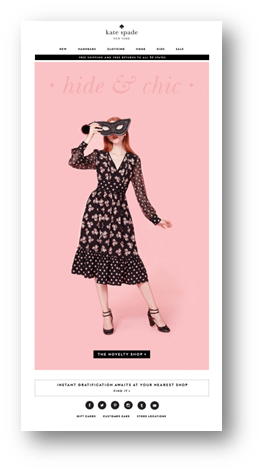
Missguided doesn’t just have products to purchase, but links to related content. The links will ultimately lead to a product page, but this sort of copy will give the recipient added reason to stay subscribed and keep engaged.
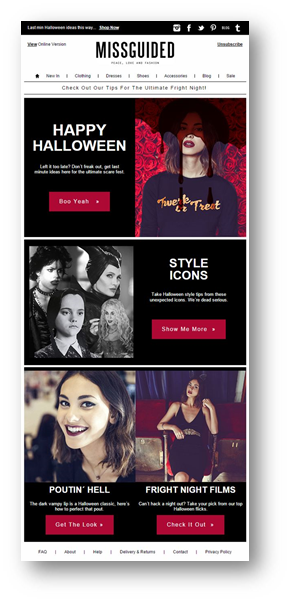
Singles’ Day
Singles Day created in China by Alibaba back in 2009 falls every year on 11/11 as an anti-Valentine’s Day celebration. Although prominently a Chinese sales holiday, the trend is becoming increasingly more global, as more and more businesses are getting involved.
So, should you get involved?
Well, Mckinsey states that in 2018 “Singles Day sales made three times more than Black Friday and Cyber Monday combined.” It could be huge. Why not consider it?
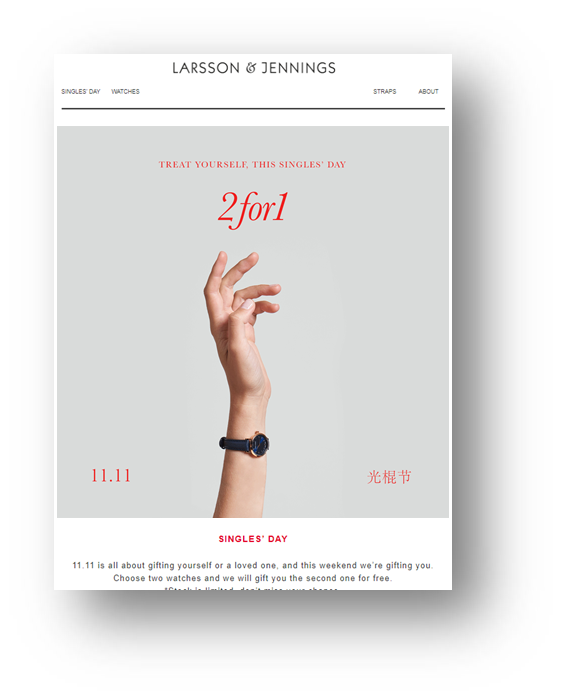
Something else to consider is the tactic FatFace has adopted: a charity-focused Black Friday. It’s great for brand-building, and consumers love a brand backing a cause that they can also get behind, and it’s also a bit of an anti-Black Friday move which tends to go down well. The jury’s still out on whether the campaign is good for sales however….
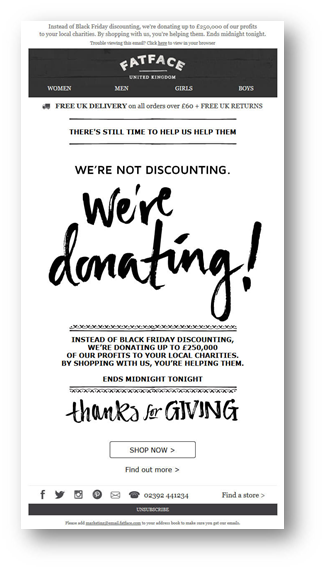
Black Friday
Do your customers need to save a date and act fast, or risk losing out on an offer? Each of these emails should be looking to go further than just a GIF but also drive home that urgency I mentioned earlier with countdown timers.
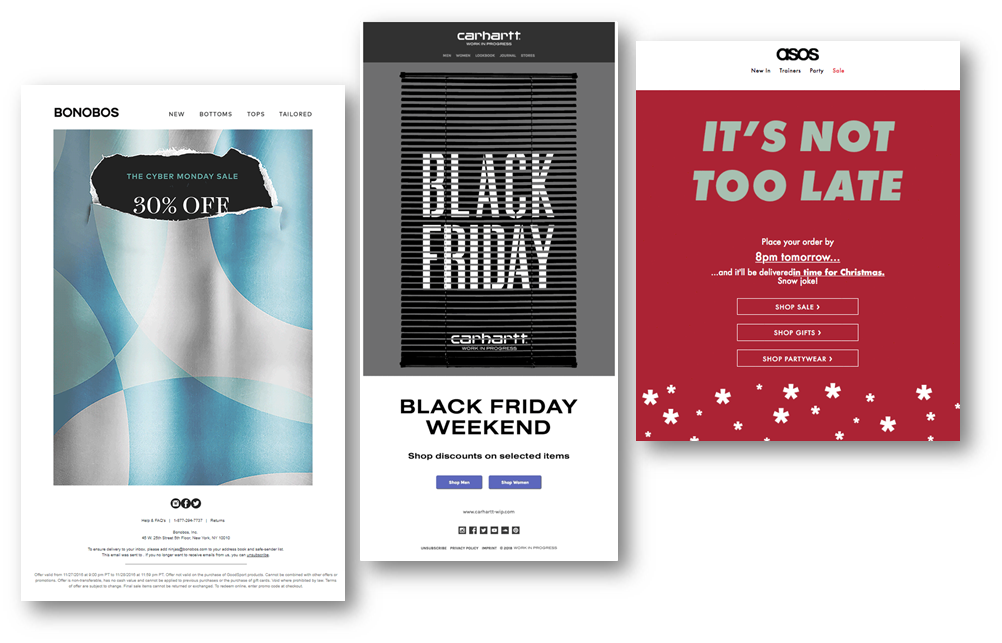
AMP for email
This email from Nest is where we all want to be. They pulled out all the stops with this AMP email. But what is AMP?
Well…AMP (Accelerated Mobile Pages) is a framework from Google to add interactivity inside your emails so you can do some cool stuff. In this email, Nest’s recipients could add items to their shopping cart directly from their inbox.
A neat feature that significantly elevated the User Experience. Which around this time of year is vital.
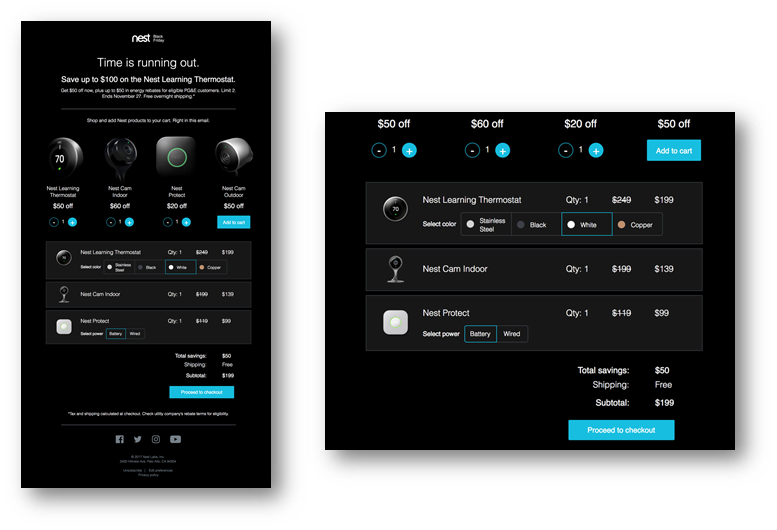
So few brands take the time to truly optimize their email marketing; making it a priority is a simple way to stand apart from competitors and produce tremendous results. Which is why in the latest release of the platform 20four we’re offering our clients functionality like this.
In summary
- Segment and personalize: Think of the particular occasion and make sure you’re targeting the right people for it. Re-engage if you can, but don’t overload customers with too much over the holiday period.
- Automate: Make use of post-purchase, abandoned carts, and countdowns to engage, convert, and excite your audience.
- Seasonalize: Have fun with it. Get your audience excited to receive emails from you, but make them functional. Be helpful and don’t make your customers rummage around to get what they came to your site for – be clear and get to the point.



